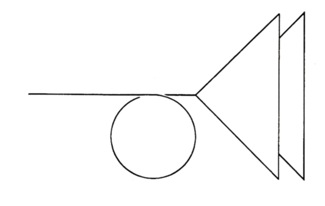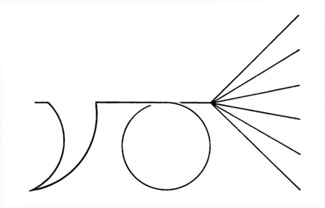Spacetime Donuts

 SPACETIME DONUTS
SPACETIME DONUTSRudy Rucker
Copyright © 1981, 2008 by Rudy Rucker
Published by E-Reads.
All rights reserved. No part of this book may be reproduced in any form or by any means, except for the inclusion of brief quotations in a review, without permission in writing from the publisher.
All characters in this book are fictitious. Any resemblance to actual persons, living or dead, is purely coincidental.
Foreword to the Second Edition
Recently I decided it would be nice to make some of my older books readily available. So I got in touch with my one-time editor John Douglas, and we agreed to reissue
Spacetime Donuts
and
The Sex Sphere
in electronic book and in print-on-demand formats.
Initially I'd thought I might leave
Spacetime Donuts
essentially untouched, preserving the historical document intact. But I found I couldn't resist tweaking the text. I'm a writer after all, and revising novels is what I
do
. I wanted to make this new edition as easy as possible to enjoy.
So I smoothed the prose without overly diluting the attitude. The book remains a wild ride through the philosophy of science, and one of the very first cyberpunk novels.
Special thanks to my daughter, Georgia Rucker, for designing the cover for this edition, based on a new painting that I made.
—Rudy Rucker
Los Gatos, California,
August 19, 2008
Events strung themselves together in such a way that I was writing a Ph.D. thesis in set theory at Rutgers in 1972. Rutgers is near Princeton, where the great philosophical genius Kurt Gödel lived. I met him a couple of times and was profoundly affected. The meetings are described in Chapter Four of my pop philosophy book,
Infinity and the Mind
(Birkhäuser Boston, 1982).
Infinity and the Mind
also contains (in Chapter One) my attempt at an explanation for
Spacetime Donuts
' main science gimmick: circular scale. The idea is sort of to take the Golden Age story "He Who Shrank," and print it on a roller towel where the two ends connect. I had a vision similar to Vernor's of the circular scale while perched in a tree near our apartment in Highland Park, New Jersey, in 1972.
One hard-science point which should be addressed is my use of miniature black holes. Recent theoretical work seems to indicate that such objects are unstable and cannot exist. But Holeflaffer's 2038 technique of magnetic monopole injection will, for all practical purposes, eliminate this difficulty.
My wife Sylvia and I saw the Rolling Stones play in Buffalo in 1976, the week before I started writing
Donuts
. Someone scalped tickets to us outside, and we ended up in the third row. It had a big effect on me . . . the great thing was that the music was so loud you couldn't tell, after a while, what the song was. Another big musical influence on this book is Frank Zappa, especially his album,
Apostrophe
'.
A less apparent borrowing is from Thomas Pynchon's
Crying of Lot 49
, which deals with, among other things, a certain symbol, a sort of muted postal horn looking like this:

The plot of
Spacetime Donuts
is, to a certain extent, based on this symbol. More precisely, the plot looks like this:

Parts I and II of
Spacetime Donuts
were published in
Unearth
(issues 7 and 8, respectively). They were forced to stop publishing before Part III could appear. But now here it is at last, complete and unexpurgated, the underground neo-SF classic, step right in!
—Rudy Rucker
Lynchburg, Virginia,
May 7, 1981
They called it "Us" then instead of "America." As in the popular slogan, "Us is Users and Users is Us." The Governor said that in most of his speeches; which always ended, "Us needs you 'cause you're Younique."
Which was a load of crap, natch. There were Drones and there were Dreamers, and that was about as unique as it got.
The Drones lived in robot-built suburbs. In the daytime they rode the walk-tubes to their offices in the City. Their main job was to fill out probing questionnaires.
The Dreamers lived together in vast apartment blocks. It was easy to spot a Dreamer because of the socket in the base of the skull. If you were a Dreamer, you plugged a wire like a phone cord into that socket every night.
The Drones' questionnaires and the Dreamers' brainwaves all ended up inside Phizwhiz, a vast network of linked computers and robots. Phizwhiz always knew what the Users wanted. If what they wanted was impossible or unsafe, then it was Phizwhiz's job to change the Users' minds before they found out that they wanted something impossible or unsafe. Phizwhiz did this by continually adjusting the Hollows, which everyone watched.
Hollows were holograms . . . three-dimensional, full-color, life-size images which talked and flickered all day long. Everyone had a small padded room called the "Nest" with a Hollows receiver on the floor. In your Nest you could lean against the soft wall and be on a yacht in the Mediterranean, or alone with the Governor while he told you a secret; at the scene of a Public Safety raid, or in bed with a friendly and beautiful couple.
It was all so real that the Users—Drones and Dreamers alike—wanted little else from life. Which was just as well, since Phizwhiz had come to do all the real work there was to do. This was partly because of human laziness, and partly because Phizwhiz had been programmed to value human life above all else. People had tended to hurt themselves when they worked in factories, fields, and laboratories. So by the time 2165 rolled around, Phizwhiz had it set up so that the average User never touched the controls of anything more dangerous than a cold-water tap.
It was an easy life, and with Phizwhiz picking your brain and manipulating the Hollows, you'd usually been psyched into dropping a gripe before you knew you had it. Usually. But there were some problems which were hard to forget about. Like the fact that the machines never did anything quite right. And the fact that there were no real changes anymore. No new inventions, no new ideas, not even any really new shows on the Hollows. Phizwhiz was happy, but Us was bored.
It occurred to someone that Phizwhiz might be more creative if a few human brains could be built into the network. The Governor appealed to the Dreamers to come plug their brains into Phizwhiz's full logical space, and a few ambitious volunteers turned up.
This kind of hook-up was something quite different from the gingerly probing of the Dream Machine, that electronic poll-taker which nightly monitored the collective response of the Dreamers' brains to various weak currents and waveforms. In fact, the incredible thought amplification and information overload experienced upon
full
brain interlock with Phizwhiz turned all of the sane and healthy people who tried it into drooling undesirables instants after they plugged in.
It began to look like the Users were stuck with their tepid, steady-state society. But then the Angels appeared.
Chapter 1: Vernor Maxwell
Vernor Maxwell grew up in a Dreamtown high-rise. When he was thirteen his father took him in to get his plug installed, and the family was awarded a new receiver for the Hollownest. At first the plug frightened him, and he would lie awake for hours while the alien images and sensations trickled into his brain from the Dream Machine. Soon, however, he began to feel a certain pleasure, almost sexual, at the dark nightly joining of his mind with all the others. Sometimes he would imagine bright impulses passing out of his plug, through the Dream Machine, and into some young girl's pure brain. The older kids bragged about actually plugging their brains directly into their girlfriends' brains, and they would show Vernor the short lengths of co-axial cable which they used.
There was no school; the Hollows' morning line-up of kiddie shows provided all the education that the Users' children would ever need. No one checked if the kids watched the shows, but they didn't have to. The shows were fun, and Vernor rarely missed them. When he got bored he would fool with the controls on the Hollow receiver until the Nest was filled with flying blobs of light and fragmented images. After awhile his mother would come in and yell at him to fix it. He would retune so that the Hollows took on their normal wavering and grainy appearance, then go out in the street to play with his friends.
By the time he was sixteen, the "play" consisted mainly of getting twisted on tranks and seeweed. Users generally took the two together, trans-steroid tranquilizers and reefers of seeweed. Seeweed was a mutated aquatic strain of
cannabis sativa
. All you had to do was drop a seed into a bucket of urine, and six weeks later you had a half-pound of seeweed. The grownups said you'd go crazy if you smoked it without taking tranks to smooth the trip, and they may have been right; but the kids continued to function pretty well after they discovered that tranks just took the edge off the weed.
A lot of Dreamer kids were into electricity, too, feeding it raw in through their skull plugs. You could hook a regular dry-cell battery to your plug; it would make you come for half an hour if you did it right . . . and pass out in convulsions if you did it wrong. Of course, batteries were illegal, but they weren't too hard to get. Not much harder than the drugs, which
were
legal for anyone over eighteen. Legal and illegal were not, after all, very important concepts in Dreamtown. The City had a police force, known collectively as the loach, but the loach tended to stay out of Dreamtown. The Hollows kept down any large-scale unrest which the Dream Machine detected, and most Dreamers didn't own anything worth stealing.
The more sophisticated kids sent
pulsed
electricity from hand-cranked dynamos in through their plugs and called themselves electrofreaks. Vernor tried it a couple of times, had an epileptic fit, and gave it up. He had begun to wish he didn't have a plug at all. There was a passive, addicted feeling to plugging in every night, and lying there hooked in with all the other Dreamers, fleshly components of Phizwhiz. After spending a night with the soft knob at the back of your neck, while thoughts and feelings ebbed and flowed through the coiled cable, you never really knew what they had put in and what they had taken out. Some mornings you felt like you had dreamed everyone's dream, all tangled together, and you couldn't meet peoples' eyes . . . but no one talked about it.
When he was twenty, Vernor started hanging around the library. Since there were so many people and so few real jobs, there was no encouragement to be anything other than a Dreamer, but if you were interested, you could study just about anything with the recorded Hollowcasts in the library. Vernor was interested in science, and he went through most of the introductory science courses which had been saved on infocubes. Physics and mathematics attracted him in particular, and soon he had exhausted the library's supply of infocubes in these areas.
